|
HSE Scuba Commercial Diver Course
After many years of diving, and having a rather interesting job with
a large television broadcaster, I found myself being sent on a commercial
diving course.
There are several prerequisites to being a commercial diver. You have
to be fit enough to pass a medical every 12 months. The medical includes
lung function, blood, hearing, ECG and a step-up exercise tests.
Next was the recompression chamber appreciation. In the commercial world
surface decompression is practised and an understanding of how these chambers
work is a important.
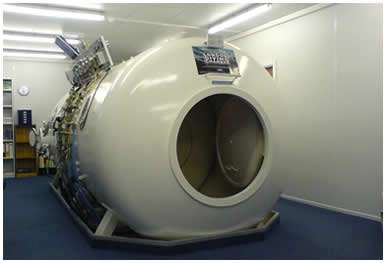 |
The session includes some fundamental theory about decompression
sickness and recompression profiles. There is an explanation of
the chamber function, a dry dive to 40m and the chance to operate
it under supervision. They also tell you about materials that are
not allowed in the chamber. The use of O2 under pressure means there
is a risk of fire, although minimal, and list includes oil, nylon
clothes, cigarette lighters and amazingly biro pens.
|
Next - First Aid at work. Fortunately I’d already
completely similar training through work and was exempted.
The HSE Scuba course
I opted to train with Andark in Southampton (http://www.andark.co.uk/diving/hse-pro-scuba/).
This company has diversified widely. They do commercial operations
and a wide variety of training not only in diving but also underwater
escape for Oil Rig workers and sailors.
To successfully pass the course you have to complete an A4 folder
full of competencies; each to be progressively dated and signed.
You also have to pass four theory exams with an 80% pass mark. The
papers are for SCUBA Diving, US Navy tables, Canadian tables and
HSE legislation. Much of the theory learning is by reading the dive
manuals and all the course papers Andark provide. Each evening I
would go to the pub for dinner and have my books out on the table
studying while I waited for the meal to arrive.
Joining me on the course were Bernie Saupe and Danni Seliger. Bernie
is ex army and is a very fit endurance athlete and personal trainer.
He had never done any sports diving and had just completed his PADI
dive training before joining the course.
|
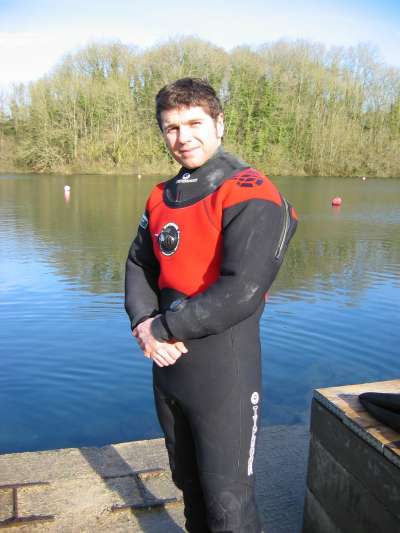
Bernie Saupe |
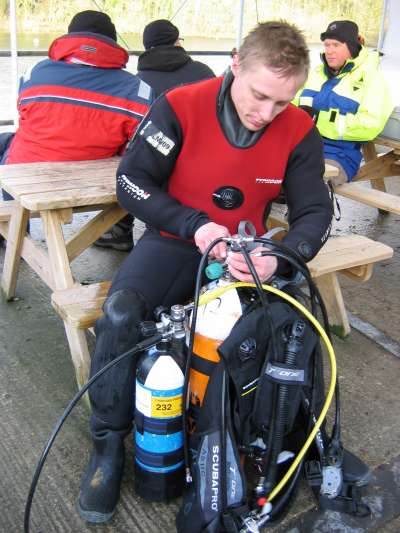
Danni Seliger |
Danni is from Denmark. He is in the process of completing a thesis
in marine archaeology and spent last summer working an ancient wreck
in Poole harbour. It is hard to make living working in marine archaeology
and so he plans to be a commercial diver and do the archaeology
where he can.
It was the beginning of February 2011. Much of the diving was conducted
in Vobster Quay (http://www.vobster.com/)
near Bath. This flooded stone quarry never gets that warm even in
the summer. At that time the water temperature reached no more than
5ºC. We dived with 7mm neoprene drysuits with undersuits and
5mm hood and gloves. Even then it was cold! Our lead instructor
was Marc Botterill, ably assisted by Jeff Emmerson and Alan Lamblin
our standby diver.
|
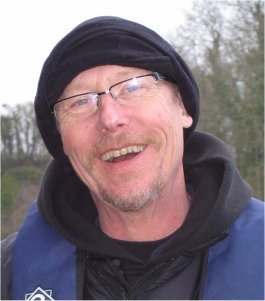
Jeff Emmerson |
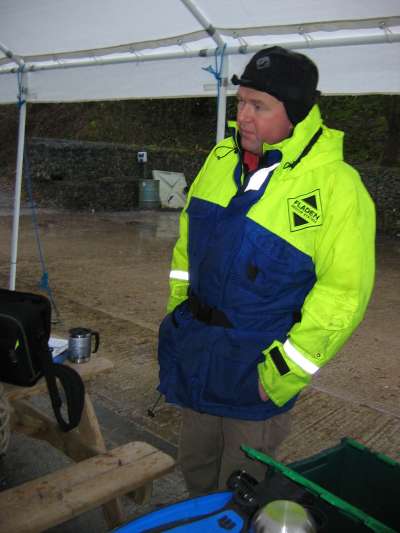
Marc Botterill |
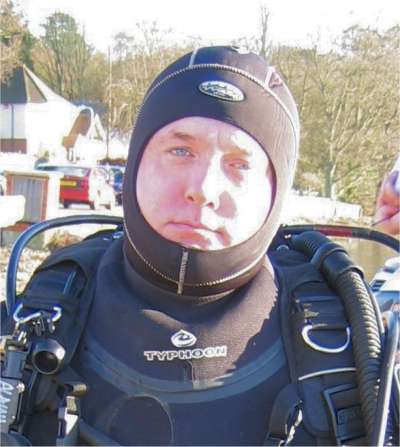
Alan Lamblin |
|
We quickly moved on from using regular aqualung and half mask to
using the Interspiro full face mask. The face mask has five point
strapping, can be fitted with either wireless or cabled communication
and has a neat block of rubber that you shove up under your nose
to aid ear clearing. There’s one big snag, it only comes in
one size and my face was the wrong shape. On many of the dives air
would exhale past the mask seal into my hood causing big buoyancy
problems as it blew up my hood like a balloon. |
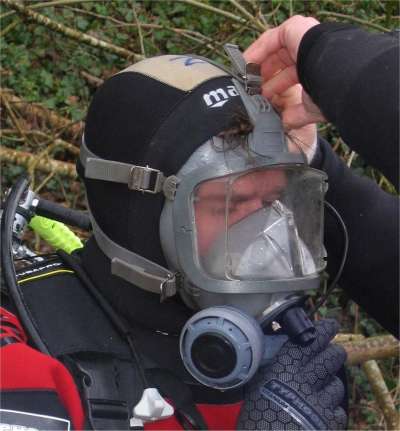
Interspiro full face mask |
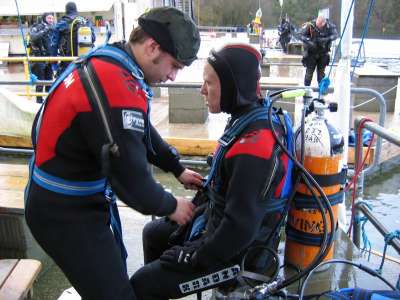
Bernie acting as tender dressing Dannii |
Apparently using a smooth lining hood inside out and the mask on
top is a good solution. Unfortunately I didn’t have one so
borrowed a hood and knifed a hole to let the air out instead. We
assisted each other to dress into the kit and to run through and
report the safety and bailout checks to the Dive Supervisor (Marc).
We also took it in turn to act as surface standby diver.
Each day was a different exercise. The worse one for me was the
navigation. Bernie and I dived together. One had an SMB, the other
a compass. Using the radio comms we were given bearings and maximum
depths to navigate. It should have been easy except with my mask
leaking and poor buoyancy control it was a nightmare. As I swam
I held the mask in place and swept the air from my hood. We both
succeeded but by the time we got back to 5m I was hugging a rock
and cursing! Marc then decided to throw a rescue scenario at me.
“Topside Diver 2 we have lost comms with Diver 1”. Clearing
as much air from my hood I swam down Bernie’s lifeline. “Topside,
Diver 2. Diver 1 is unconscious but breathing. Please assist me
up”. Naturally I get no reply from Topside and had to resort
to 4 pulls and 2 bells on Bernie’s lifeline as an alternative
signal to assist me up. These diver rescue scenarios were played
out many times over the next two weeks in Vobster and a mud hole
called the Hamble River.
|
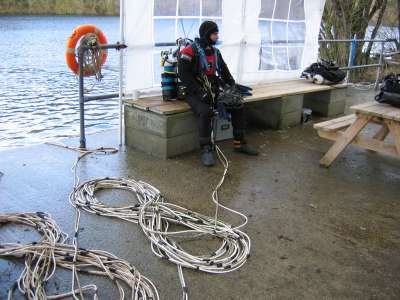
Johnny no mates Standby Diver |
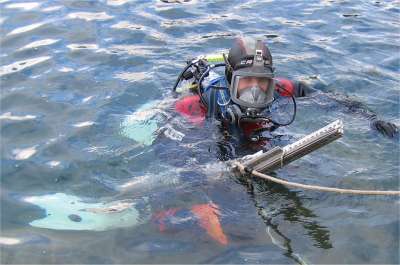
Dexion box dive |
One of the best exercises we did was building a box from dexion
frame. We were now diving in harnesses with no BCs and cabled comms.
Danni, Bernie and I dived in sequence so much of the time we dived
solo. It is surprising how hard it is to fit dexion together with
nuts and bolts when wearing gloves and your finger tips are numb
with the cold. By the time I got in the frame had been built and
pretty much dismantled again by Danni and Bernie. This time my mask
didn’t leak and I went to work with vigour. I got the top
and bottom parts of the frames built and then started on the uprights.
My fingers were getting really numb and I kept dropping the nuts.
Even though my face was only inches from the gravel bottom finding
the little suckers was not easy. Unfortunately I ran out of time,
but I had enjoyed myself!
|
We went on night dives; a 27m solo dive surveying
a car; roped diver dive and a survey dive where we mapped objects
underwater by taking measurements and triangulating. The final
day’s diving was two sea dives on a hard boat in Portland
Harbour. Although sea conditions were smooth as we left Weymouth
by the time we dived it was raining and quite rough. Shame for
those staying topside!
The plan was to survey the Landing Craft up against the sea wall
and to dive the Countess of Erne. This was very much my backyard.
We descended the sea wall and found nothing but sand at the bottom.
I had noticed a slight drift before diving so turned left and ran
along the sea wall. We quickly found the Landing Craft and did our
survey.
By the time we were back onboard the boat I think the others were
not enjoying the journey so much. Marc suggested instead of diving
the Countess we should do a quick turnaround and dive the Dredger.
I hate the Dredger so Marc agreed that 20 minutes was enough to
get signed off. Unfortunately the Dredger lived up to my expectations,
it was rubbish but at least it had stopped raining by the time we
got back. |
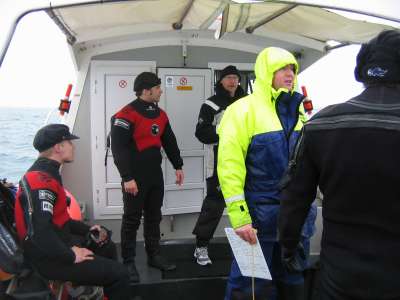 |
The final day was the HSE legislation exam, which was a total
bitch, but we all passed. Just for luck Marc had Alan fake falling
down stairs and breaking an ankle to test our First Aid skills.
It was a great course, well taught and I learnt a lot. My thanks
to Marc and his team at Andark; and to Danni and Bernie for being
such great company.
|
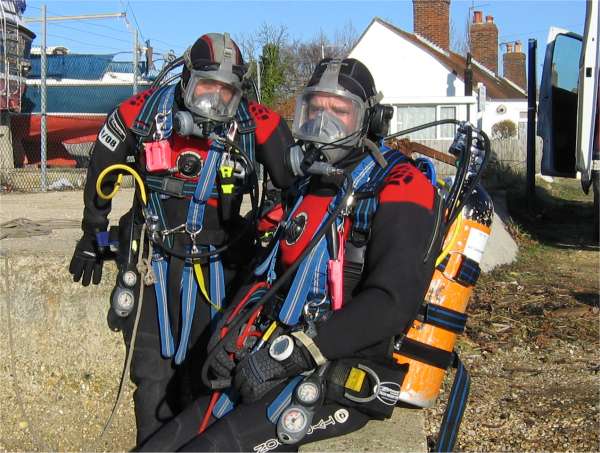
Danni Seliger and Nigel Ealand prepare to dive the Hamble River,
Southampton |
|
|
|











